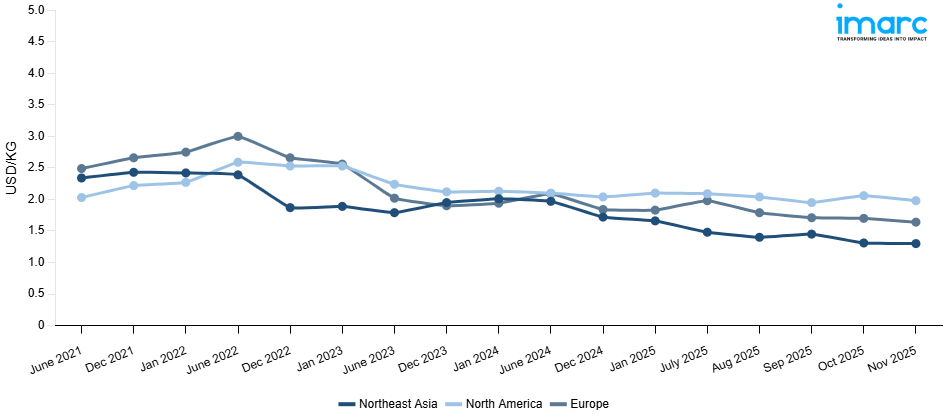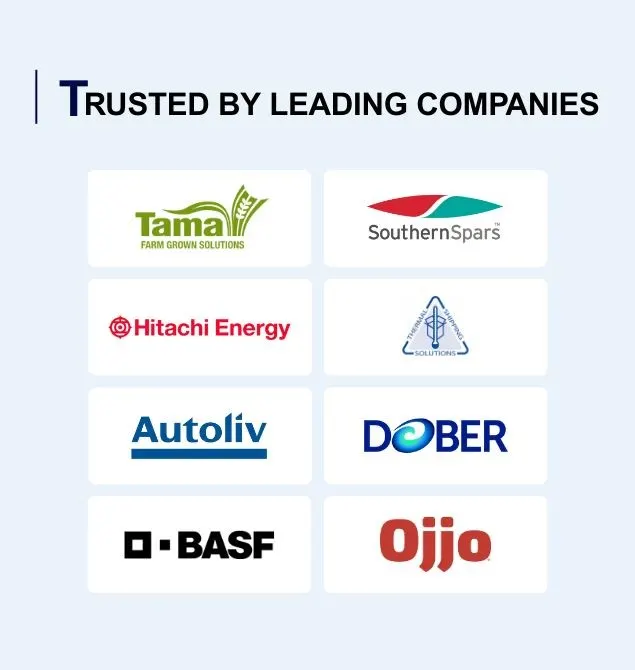
Caprolactam Prices, Trend, Chart, Demand, Market Analysis, News, Historical and Forecast Data Report 2025 Edition
Caprolactam Price Trend, Index and Forecast
Track real-time and historical caprolactam prices across global regions. Updated monthly with market insights, drivers, and forecasts.
Caprolactam Prices November 2025
| Region | Price (USD/KG) | Latest Movement |
|---|---|---|
| Northeast Asia | 1.30 | -0.7% ↓ Down |
| Europe | 1.64 | -3.5% ↓ Down |
| North America | 1.98 | -3.8% ↓ Down |
Caprolactam Price Index (USD/KG):
The chart below highlights monthly caprolactam prices across different regions.

Get Access to Monthly/Quaterly/Yearly Prices, Request Sample
Market Overview Q3 Ending September 2025
Northeast Asia: The rise was primarily driven by strong downstream demand from the polyamide and nylon sectors in China, Japan, and South Korea. Supply-side factors, including limited domestic production capacity and higher raw material costs, contributed to the price increase. International shipping rates and port handling charges also added to cost pressures, particularly for imported cyclohexanone and adipic acid, key feedstocks. Currency fluctuations, especially the relative strength of the Japanese yen against the US dollar, further influenced import costs. Domestic logistics, including inland transportation and storage for industrial-grade Caprolactam, experienced marginal cost increases due to higher energy and labor expenses. Additionally, compliance costs for environmental regulations and safety standards in production facilities modestly affected overall pricing dynamics in the region. The combination of constrained supply, elevated raw material costs, and consistent industrial demand sustained the observed upward movement in caprolactam prices across Northeast Asia.
Europe: The downward movement was largely due to softer demand from automotive and textile manufacturing sectors across Germany, France, and Italy, reflecting slower economic activity in key downstream industries. On the supply side, European producers maintained stable output levels, and some import volumes of raw materials increased, which eased pressure on local inventories. Additional factors impacting pricing included reductions in international freight costs and moderate fluctuations in port handling fees. Currency movements, particularly the euro against the US dollar, also played a role in moderating costs for imported feedstocks. Domestic logistics and transportation within Europe remained relatively stable, and compliance costs for environmental and safety standards did not exhibit major changes in this quarter.
North America: Reduced demand from nylon and polymer industries in the United States and Canada contributed to softer pricing trends. Supply-side factors, including consistent production volumes from domestic manufacturers, prevented further upward price pressures. Raw material costs, including cyclohexanone and ammonia, remained relatively stable, while international shipping costs experienced slight moderation, influencing overall pricing. Port handling charges and domestic logistics, including warehousing and inland transportation, were stable in this quarter. Currency fluctuations between the US dollar and other major currencies had minimal impact on domestic production costs. Compliance expenses related to environmental and safety regulations maintained a steady baseline and did not significantly affect pricing. Collectively, these factors led to a moderate decline in North American prices during the third quarter.
Caprolactam Price Trend, Market Analysis, and News
IMARC's latest publication, “Caprolactam Prices, Trend, Chart, Demand, Market Analysis, News, Historical and Forecast Data Report 2025 Edition,” presents a detailed examination of the caprolactam market, providing insights into both global and regional trends that are shaping prices. This report delves into the spot price of caprolactam at major ports and analyzes the composition of prices, including FOB and CIF terms. It also presents detailed caprolactam prices trend analysis by region, covering North America, Europe, Asia Pacific, Latin America, and Middle East and Africa. The factors affecting caprolactam pricing, such as the dynamics of supply and demand, geopolitical influences, and sector-specific developments, are thoroughly explored. This comprehensive report helps stakeholders stay informed with the latest market news, regulatory updates, and technological progress, facilitating informed strategic decision-making and forecasting.
Caprolactam Industry Analysis
The global caprolactam industry size reached USD 18.14 Billion in 2025. By 2034, IMARC Group expects the market to reach USD 25.29 Billion, at a projected CAGR of 3.76% during 2026-2034. The market is driven by the increasing demand for nylon in automotive and textile industries, expansion of polyamide manufacturing, rising consumption in engineering plastics, investment in sustainable production processes, and continued industrial demand from consumer goods and packaging sectors.
Latest developments in the Caprolactam Industry:
- August 2025: Hengyi Petrochemical confirmed the underway commencement of its new caprolactam plant in Qinzhou, Guangxi, China. This facility is part of a comprehensive caprolactam-polyamide integrated industrial project with an annual capacity of 1.2 million tons.
- November 2024: HighChem Co., Ltd. acquired Sumitomo Chemical's vapor-phase Beckmann rearrangement process for caprolactam production, a method that produces high-quality caprolactam without generating ammonium sulfate as a byproduct. This acquisition positions HighChem to globally license this technology and supply catalysts from its own facilities, potentially influencing the caprolactam market by offering a more sustainable and efficient production method.
- October 2024: BASF introduced Ultramid® LowPCF and Ultramid® ZeroPCF, offering caprolactam with reduced and net-zero CO₂ footprints, aiming to offer more sustainable options for caprolactam users.
- March 2022: DOMO Chemicals achieved a milestone by delivering its 5 millionth metric tons of caprolactam at its Leuna site. The production capacity had been progressively increased throughout this time to reach the current level of 176,000 metric tons annually.
- October 2022: Xuyang Group's caprolactam expansion project in Cangzhou Park increased its production capacity to 750,000 tons/year. The second phase of the expansion project achieved stable operation after reaching full load in 24 days, consolidating Xuyang Group's position as a vital player in the coastal polyamide industry.
Product Description
Caprolactam is a colorless crystalline organic compound and a key chemical intermediate used primarily in the production of nylon-6 fibers and resins. Recognized for its high purity and reactivity, caprolactam occupies a central position in global polymer and textile manufacturing. Its unique property of polymerizing into high-strength nylon makes it indispensable in producing industrial fibers, automotive components, engineering plastics, and packaging materials. Caprolactam enhances product durability, heat resistance, and mechanical performance, making it critical for industries such as automotive, textiles, electronics, and consumer goods. Its widespread industrial application and pivotal role in nylon production position it as a core chemical in global manufacturing supply chains.
Report Coverage
| Key Attributes | Details |
|---|---|
| Product Name | Caprolactam |
| Report Features | Exploration of Historical Trends and Market Outlook, Industry Demand, Industry Supply, Gap Analysis, Challenges, Caprolactam Price Analysis, and Segment-Wise Assessment. |
| Currency/Units | US$ (Data can also be provided in local currency) or Metric Tons |
| Region/Countries Covered | The current coverage includes analysis at the global and regional levels only. Based on your requirements, we can also customize the report and provide specific information for the following countries: Asia Pacific: China, India, Indonesia, Pakistan, Bangladesh, Japan, Philippines, Vietnam, Thailand, South Korea, Malaysia, Nepal, Taiwan, Sri Lanka, Hongkong, Singapore, Australia, and New Zealand* Europe: Germany, France, United Kingdom, Italy, Spain, Russia, Turkey, Netherlands, Poland, Sweden, Belgium, Austria, Ireland, Switzerland, Norway, Denmark, Romania, Finland, Czech Republic, Portugal and Greece* North America: United States and Canada Latin America: Brazil, Mexico, Argentina, Columbia, Chile, Ecuador, and Peru* Middle East & Africa: Saudi Arabia, UAE, Israel, Iran, South Africa, Nigeria, Oman, Kuwait, Qatar, Iraq, Egypt, Algeria, and Morocco* *The list of countries presented is not exhaustive. Information on additional countries can be provided if required by the client. |
| Information Covered for Key Suppliers |
|
| Customization Scope | The report can be customized as per the requirements of the customer |
| Report Price and Purchase Option |
Plan A: Monthly Updates - Annual Subscription
Plan B: Quarterly Updates - Annual Subscription
Plan C: Biannually Updates - Annual Subscription
|
| Post-Sale Analyst Support | 360-degree analyst support after report delivery |
| Delivery Format | PDF and Excel through email (We can also provide the editable version of the report in PPT/Word format on special request) |
Key Benefits for Stakeholders:
- IMARC’s report presents a detailed analysis of caprolactam pricing, covering global and regional trends, spot prices at key ports, and a breakdown of FOB and CIF prices.
- The study examines factors affecting caprolactam price trend, including input costs, supply-demand shifts, and geopolitical impacts, offering insights for informed decision-making.
- The competitive landscape review equips stakeholders with crucial insights into the latest market news, regulatory changes, and technological advancements, ensuring a well-rounded, strategic overview for forecasting and planning.
- IMARC offers various subscription options, including monthly, quarterly, and biannual updates, allowing clients to stay informed with the latest market trends, ongoing developments, and comprehensive market insights. The caprolactam price charts ensure our clients remain at the forefront of the industry.
Key Questions Answered in This Report
The caprolactam prices in November 2025 were 1.30 USD/Kg in Northeast Asia, 1.64 USD/Kg in Europe, and 1.98 USD/Kg in North America.
The caprolactam pricing data is updated on a monthly basis.
We provide the pricing data primarily in the form of an Excel sheet and a PDF.
Yes, our report includes a forecast for caprolactam prices.
The regions covered include North America, Europe, Asia Pacific, Middle East, and Latin America. Countries can be customized based on the request (additional charges may be applicable).
Yes, we provide both FOB and CIF prices in our report.
Need more help?
- Speak to our experienced analysts for insights on the current market scenarios.
- Include additional segments and countries to customize the report as per your requirement.
- Gain an unparalleled competitive advantage in your domain by understanding how to utilize the report and positively impacting your operations and revenue.
- For further assistance, please connect with our analysts.
Why Choose Us
IMARC offers trustworthy, data-centric insights into commodity pricing and evolving market trends, enabling businesses to make well-informed decisions in areas such as procurement, strategic planning, and investments. With in-depth knowledge spanning more than 1000 commodities and a vast global presence in over 150 countries, we provide tailored, actionable intelligence designed to meet the specific needs of diverse industries and markets.
1000
+Commodities
150
+Countries Covered
3000
+Clients
20
+Industry
Robust Methodologies & Extensive Resources
IMARC delivers precise commodity pricing insights using proven methodologies and a wealth of data to support strategic decision-making.
Subscription-Based Databases
Our extensive databases provide detailed commodity pricing, import-export trade statistics, and shipment-level tracking for comprehensive market analysis.
Primary Research-Driven Insights
Through direct supplier surveys and expert interviews, we gather real-time market data to enhance pricing accuracy and trend forecasting.
Extensive Secondary Research
We analyze industry reports, trade publications, and market studies to offer tailored intelligence and actionable commodity market insights.
Trusted by 3000+ industry leaders worldwide to drive data-backed decisions. From global manufacturers to government agencies, our clients rely on us for accurate pricing, deep market intelligence, and forward-looking insights.
 Request Customization
Request Customization
 Inquire Before Buying
Inquire Before Buying
 Speak to an Analyst
Speak to an Analyst Request Brochure
Request Brochure




.webp)




.webp)












